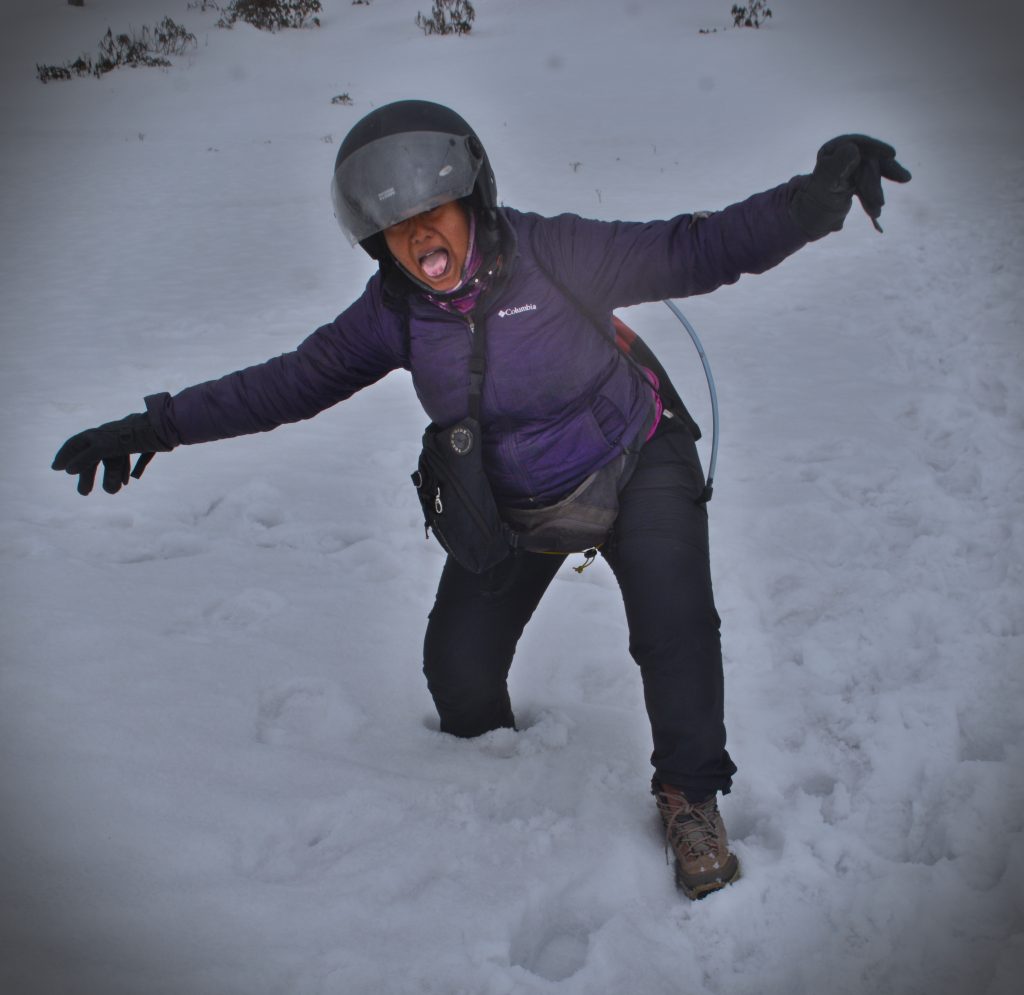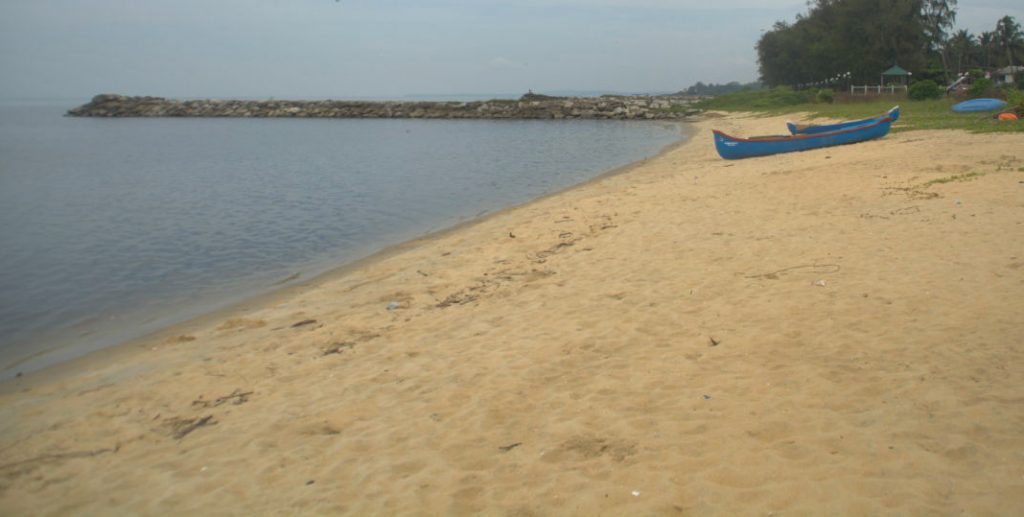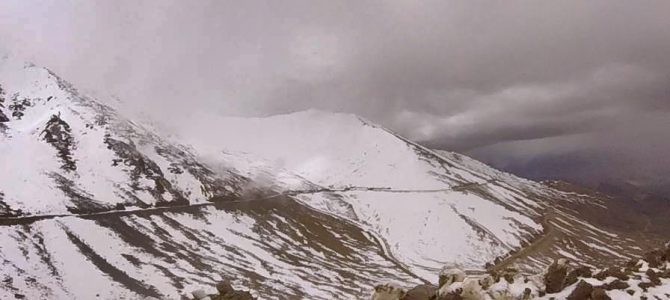India is a tropical country, with half of the country lying between the equator and the tropic of Cancer. Summers are harsh, whereas the winters can get cold, but milder than what North America or Europe faces. But then, to the northern end of India are the Himalayas, where it snows heavily. Depending on where you are in India, the winter is as diverse as the country itself. India has places like Kanyakumari in Tamil Nadu, where winter merely means that the night time temperature may drop to less than 27 degrees celsius with a pleasant breeze. At the other end of the spectrum, there is Dras in Jammu & Kashmir, which ranks as the second coldest inhabited place on earth, averaging -20 degrees celsius in winter, with the record low being -45 degrees celsius. Depending on whether you just want pleasant weather or an adventure in head-popping cold, holiday destinations may vary.
Snow

Priya tries to walk on a foot of snow in Tawang, Arunachal Pradesh.
With India being a tropical country, snow is confined to the higher altitude of Himalayas. It snows moderately in the lower Himalayas, while the Greater Himalayas receive heavy snow, to the point that they are covered in some snow even during summers. Countries like Canada, North America, New Zealand and Germany dread snow, since they know the real dangers of getting stuck in a blizzard and the tremendous effort required to just have a normal life when it snows all around you. But most Indians travel long and far to see snow. Snow for most of them is a novelty. Indians aspire to see and play with snow. We can see their eyes glow with excitement even when they spot a small patch of snow by the kerb of the road in Himachal or Sikkim.
In winter, several Himalayan mountain passes shut down and remain closed after facing a week of snow. Anticipating such snow, the locals who inhabit higher altitudes relocate to their winter residences on lower ground and sometimes to cities outside their native state. Heck, they even bring the deities of important temples down with them. E.g. Kedarnath’s idol is brought down to Okhimath, whereas Gangotri Devi is brought to Harshil.
That said, Himalayan winters have their own specialities which are not available during rest of the year.
Vistas of snow everywhere: Looking at towns covered in snow can indeed be a fairy tale experience, with great photo opportunities. Winter is the time when the British-built Himalayan hill stations in India, such as Shimla, Manali and Mussoorie look like European cities, with their wooden houses, town squares and slated roofs all covered in snow.
Train trips: If you are lucky and the trains are operational, then winter is a great time to hop on a ride from Kalka to Shimla (Himachal) or from Banihal to Srinagar (J & K). You will see pine and fir trees covered in snow and several vast open meadows in sheets of white.
Skiing: India has various levels of ski slopes. Ski resorts above those slopes offer skiing courses for beginners, intermediate and advanced skiiers. Good ski resorts are at Auli (near Badrinath, Uttrakhand), Gulmarg (near Srinagar, J & K), Pahalgham (J & K), Kufri (near Shimla, Himachal Pradesh) and Solang Valley (near Manali, Himachal Pradesh). If you are new to skiing, you can try a very basic level at one of these places.
Chadar Trek, where you walk on a frozen river: This will probably be your only opportunity to do what Jesus was supposed to have done, which is to walk on water. The trek goes along the bed of the Zanskar river, with accommodation in the form of camping in caves along the way. The Chadar trek is one of the costliest treks in India. This is because it is very remote, in the district of Ladakh in Jammu & Kashmir. The opportunity is very exclusive. The third reason is because you cannot go solo. You’d never tell the difference between hard walkable ice and fragile thin ice. A system of guides and porters is required to safely navigate on the frozen water, which is extremely slippery with zero grip. The roads that lead to Ladakh from Srinagar and Manali are closed during winter. So the only way to reach the base of the Chadar trek is by taking a plane to Leh airport from New Delhi and then subsequently using local transport provided by the adventure company which will take care of your walk. Flights are few and premium during this time of the year. So the whole activity is extremely expensive. You might get lucky with off-season discounts if seats don’t fill up.
A word of warning
However, be warned that high altitude, snow and extreme cold can cause a lot of adverse effects in your body, leading to altitude sickness, breathlessness, frost bites, snow blindness and hypothermia. The best advice we can give you is that the scenes from Hollywood and Bollywood movies are fake. Don’t imitate those scenes at all. Here are some do’s and don’ts for high altitude and snow.
- Never get to high altitude rapidly. Take your time, at least 24 – 48 hours, to go from a altitude below 5000 feet to something above 10,000 feet (this altitude and above are called high altitude). Your first day at a high altitude location should be spent in mild exercise such as walking or very light jogging. The idea is to get your lungs used to the lower levels of oxygen. While there are flights from New Delhi and Mumbai to Leh, personally we at India 360 think that those flights are not a good idea for your health since they take you from low to high altitude in a matter of a couple of hours. The flights can have really adverse effects if your daily lifestyle doesn’t include aerobic exercise.
- Always do exactly what the locals tell you. Do not let anyone from the metro cities of India give you advice about how to eat, sleep, drink or behave at higher altitudes. Locals have been there for several years, living through the difficulties of winter. Only they know best. You may have read this post from us Mumbaikars, but when you reach the Himalayas, please consult a local for better advice 😉
- Always have your layered clothes on. One layer of underwear should be covered by a layer of high quality woollen thermals, followed by your regular clothing, i.e. a full-sleeve top and full trousers and finally a padded fleece jacket. You should wear one layer of cotton socks, with woollen socks above it. The shoes must cover your leg above the ankles, preferably upto the shins. Your palms and fingers should be covered in woollen gloves. A woollen monkey cap stays on your head all the time. The cap should also go over your ears. This is how locals will be. They keep their sweaters on all day. At first, it will seem strange, but within two days, it will all make sense.
- Winter clothing is where movies show you lousily misleading scenes with heroines wearing mini-skirts, heel shoes and sleeveless tops on snow. They let their hair open with an uncovered head. You may wear such attire when you visit the Himalayas in summer and are roaming on grass meadows or town promenades during day time before 5 pm. Avoid such summer-themed dresses and wear all your layers if:
- it is winter
- it is soon to be or past sunset in ANY season, including summer.
- you are standing on a field of snow during ANY season.
- Always remember. Snow looks extremely gorgeous. But it is an evil in a beautiful disguise, a witch in the attire of a fairy. Movies are to blame for the hundreds of silly things that tourists from cities do on snow. Here are some terrible ideas.
- Holding snow in ungloved hands. You can try this at home. Trying holding an ice cube from your freezer. You will start feeling numbness. Holding snow directly over the skin of your hands without being aware of how long you are holding it can cause numbness and subsequently frostbite.
- Throwing snow at each other. Snow is soft, but compact balls of snow can be quite hard. A mis-aimed, misdirected hit can go straight for the throat or for the eyes. There is no telling how much damage will be done if that happens.
- Licking / sucking on snow. Point one, snow is made of water, but it causes dehydration. Sucking on snow will actually dehydrate you. Second, it can cause frostbite to your tongue. Third, a really hard suck can shoot some particles of snow into your throat and cause serious damage.
- Driving on snow is very tricky. Road trips will be longer due to slippery snow. It also needs special equipment like snow tyres and chains wrapped over tyres. If you have driven less than 5000 km in your life or if you have never driven even on gentle mountain roads (e.g. Nandi Hills or Sahyadris), then give up the idea of driving on your own in the Himalayan winter and hire a local vehicle with its own driver. He / she knows better. And definitely do not use a motorbike. India 360 found out the hard way while driving through Sela pass in Tawang, Arunachal Pradesh.
Sea

India is blessed with a long coastline and many beaches. Seen here is Kappad beach near Kozhikode in Kerala, where Portuguese sailor Vasco da Gama landed, thus finding a sea route between Europe and India.
India’s coastline covers huge ground (7500 km). It starts at the Arabian Sea at Mandvi in the Kutch district of Gujarat, continues through Maharashtra, Karnataka and Kerala. At Tamil Nadu’s Kanyakumari, the Arabian Sea, Indian Ocean and Bay of Bengal meet. The coastline ends in a tip, changes direction and becomes east-facing in Tamil Nadu, continuing through Pondicherry, Andhra Pradesh and Orissa, upto Diamond Harbour near Kolkata in West Bengal. That’s not all. India is blessed with two island union territories in the form of Lakshadweep and Andaman & Nicobar. Just imagine the wealth of beaches, sea shells, marine life, rock formations, sea forts and coastal cities than India enjoys. It’s staggering even to think about it. Don’t think, just act. It is during the milder weather of winter that India’s coast can be best enjoyed.

India’s coastline supports a plethora of marine life
Gujarat & Diu
The clean beaches of Kutch and Diu are yet to attract hordes of tourists. Gujarat is usually seen as a destination for temples and palaces or as a hub for business and industry. But there are some beautiful beaches tucked away in coastal Gujarat. Dwarka, Madhopur, Veraval and Porbandar are some beautiful beaches. And who can forget Dandi beach, graced by the Father of our Nation in a bid to defy the salt act?
Maharashtra
You will fall in love with Maharashtra’s coastline the same way you do with the mountains and snow of Himalayas. Among all the states, the 600 km of Maharashtrian coastline offers you so much variety and such a wide experience that it is hard to pack an end-to-end trip even if you give it a week. You may have better heard of Maharashtra’s coastline by the name of Konkan. There are 6 districts in Konkan, starting from Palghar adjoining Gujarat and continuing upto Sindhudurg which borders Goa. The mega-city of Mumbai is along the way. Here are some activities to enjoy in Konkan winter.
- Beaches: Maharashtra has a plethora of beaches, some of them crowded and touristy, but some tucked away in quiet corners.
- Sea forts: Engineering marvels such as Vasai fort, Alibag’s Kulaba fort, the genius of Murud Janjira, and then Vijaydurg and Sindhudurg, two forts commanded by the Great Maratha admiral Kanhoji Angre.
- Cities: Mumbai, Ratnagiri and Malvan are some cities on the Konkan coast. Each city has its vibrant culture and history.
- Vantage views: Adjoining the beaches of Korlai, Velneshwar, Harnai and Velas are small hills you can trek to or drive to and see entire stretches of beaches and villages from a vantage point. The beautiful coastal highway runs parallel to the sea at all times in the Ratnagiri district.
- Bird life: Winter is the time when birds from as far as the Arctic migrate to India’s coastline, Maharashtra being one of them. It is great time to spot exotic species.
- Olive Ridley turtles: On the beaches of Velas and Kelshi, both in Ratnagiri district, the month of February is when the endangered species of Olive Ridley turtles crawl out of the eggs laid on the beach and into the sea. Hundreds of tiny turtles can be seen tottering at a slow pace from the beach to the waves of the sea.
- Beach resorts: Maharashtra Tourism Development Corporation (or MTDC) operates several cosy resorts by the beach at several locations in the state. All of them have fantastic views of the sea. The best resorts are at Harihareshwar, Velneshwar and Tarkarli. In addition, several homestays accredited by MTDC are run by locals. These can be great places to spend your beach-side vacations.
- Temples: Several temples are located right on the beach shore in Maharashtra. These are: Harihareshwar, Velneshwar, Ganpatipule, Kunkeshwar and Redy to name a few.
- Water activities: Several beaches have water sports such as motorboating and parasailing. The Tarkarli beach in Sindhudurg has operators offering scuba diving.
Goa
Beaches of Goa from Anjuna in north Goa to Palolem in south Goa are extremely happening during winter, especially in the week from Christmas to New Year, when carnivals happen. Each of Goa’s beaches is unique in its own way and you will never get tired of spending time there. Anjuna, Calangute and Palolem are shoppers’ paradises where you can pick good quality western clothes and beachwear for a bargain. Anjuna, Arambol and Morjim also has several budget friendly backpackers’ hostels with zero restrictions, making it a paradise for solo travellers and backpackers looking to let their hair down.
If you consume alcohol, then look no further than Goa. All drinks are available at cheaper rates than the rest of the country. And then there are happy hours, which drives the costs even lower. Neither members of India 360 drinks alcohol, so we cannot tell you which bars are the best. But a lot is spoken about Tito’s between Baga and Calangute beaches, the two most happening beaches in Goa. Tito’s also has an attached discotheque.
Karnataka

The 123-feet tall Shiva statue on Murudeshwara beach
With the exception of Karwar, Udupi and Mangalore, beaches in Karnataka are less talked about. There are several in number, but not much tourism. Beaches like Gokarna are just starting to pick up tourism on scale. Right now, the most visited beach in Karnataka is perhaps Murudeshwara, but not for the beach. Right on the beach is a temple with a 123-feet statue of Lord Shiva in a sitting posture.
Kerala
Beaches in Kannur in north Kerala are spotlessly clean and were some of the most pristine ones we saw in all of India. We would personally prefer a beach holiday in Kerala over Goa. In south Kerala, Varkala and Kovalam on either sides of Thiruvananthapuram are worth a visit and a stay. Near the shores of Alappuzha are the lakes of Vaikom, Kumarakom and Punnamada, where you can stay on houseboats for a night and enjoy a cruise.
Tamil Nadu
The best sea-side destinations in and around Tamil Nadu are Kanyakumari, Thiruchendur, Rameswaram, Dhanushkodi, Pondicherry and Chennai itself. For Dhanushkodi, you can ride all the way to the end of India with your car. It has an abandoned ghost town which was destroyed in cyclone of 1964. Meter gauge tracks, railway station with water tanks to feed the steam engine are all relics worth seeing. The floating stones unique to this city could be found in a few places including temples where people worship them and consider it as a proof of the Ram Sethu built by the army of Ram to cross over to Lanka.
The French-built Pondicherry has a sea-side promenade enhanced by a stay at the Aurobindo Ashram. The uniquely coloured buildings and the straight roads resembling those of Paris are a sight to see. At Chennai, we have the world’s second-widest beach. The Marina beach is an excellent place to watch the sun rise and also to take a stroll in the evening.
Orissa
A visit to Orissa in the winter can cover Cuttack, Bhubaneshwar, Konark temple, Puri and Chilika lake.
Conclusion
As you can see, diversity is the main trump card played by India when it comes to tourism. Winter shows up in different colours and moods throughout the country. But we have shown you two choices in our post, one following the mountains and another, the sea. The choice is yours to pick. So just pack your bags and leave home when the leaves start to dry and fall from the trees.

